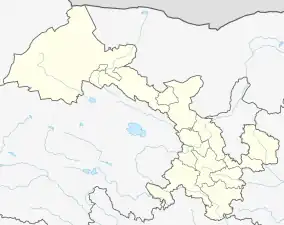Tangwang
唐汪镇 | |
|---|---|
 Tangwang | |
| Coordinates: 35°47′47″N 103°32′18″E / 35.7963716°N 103.5383762°E | |
| Country | China |
| Province | Gansu |
| Prefecture | Linxia Hui |
| County | Dongxiang |
| Population | |
| • Total | 12,616 |
Tangwang, formerly known as Tangwangchuan (唐汪川) is a town of Dongxiang Autonomous County, Linxia Hui Autonomous Prefecture, Gansu, China.[1]
The town had a multi ethnic populace, the Tang (唐) and Wang (汪) families being the two major families. The Tang and Wang families were originally of non-Muslim Han Chinese extraction, but by the 1900s some branches of the families became Muslim by "intermarriage or conversion" while other branches of the families remained non-Muslim.[2]
People in the area have changed their ethnicity by marrying members of other groups or converting to their religion. The Tang and Wang families are now composed of all three different ethnic groups, with Han Chinese, Hui and Dongxiang people. The Hui and Dongxiang are Muslims.[3]
Tangwangchuan and Hanjiaji were notable for being the lone towns with a multi ethnic community, with both non-Muslims and Muslims.[4]
The Kuomintang official Ma Hetian visited Tangwangchuan and met an "elderly local literatus from the Tang clan" when he was on his inspection tour of Gansu and Qinghai.[5]
In the local music of Hezhou/Linxia, a Han and Hui song called "Hezhou" contains the verse "tang wang chuan you yi ge" (唐汪川有一个) in its third Ling.[6][7]
In 1956, ancient pottery was found at the town, giving its name to the Tangwang Culture.[8] In 2009, murals dated to 1673 were found in a cave in Tangwang.[9]
See also
References
- ↑ "2019年统计用区划代码". www.stats.gov.cn. Retrieved 2021-03-26.
- ↑ Gail Hershatter (1996). Gail Hershatter (ed.). Remapping China: fissures in historical terrain (illustrated ed.). Stanford University Press. p. 102. ISBN 0-8047-2509-8. Retrieved 17 July 2011.
- ↑ M.E. Sharpe, Inc, International Arts and Sciences Press (2007). Chinese sociology and anthropology. M.E. Sharpe. p. 42. Retrieved 17 July 2011.
{{cite book}}: CS1 maint: multiple names: authors list (link)(Original from the University of Virginia ) - ↑ Jonathan Neaman Lipman (1997). Familiar strangers: a history of Muslims in Northwest China (illustrated ed.). University of Washington Press. p. 145. ISBN 0-295-97644-6. Retrieved 17 July 2011.
- ↑ University of Cambridge. Mongolia & Inner Asia Studies Unit (2002). Inner Asia, Volume 4, Issues 1-2. The White Horse Press for the Mongolia and Inner Asia Studies Unit at the University of Cambridge. p. 119. Retrieved 17 July 2011.(Original from the University of Michigan)
- ↑ European Foundation for Chinese Music Research (1999). Journal of the CHIME Foundation, Issues 12-13. European Foundation for Chinese Music Research. p. 80. Retrieved 17 July 2011.(Original from the University of Michigan)
- ↑ Martin Hartmann (1921). Zur Geschichte des Islam in China. Vol. 10 of Quellen und Forschungen zur Erd- und Kulturkunde. W. Heims. p. 14. Retrieved 17 July 2011.(Original from the University of Michigan)
- ↑ Dani, Ahmad Hasan; Masson, Vadim Mikhaĭlovich (1999). History of Civilizations of Central Asia. Motilal Banarsidass. ISBN 978-81-208-1407-3.
- ↑ "甘肃省东乡县唐汪镇首次发现大面积石窟壁画-欢迎访问东乡族自治县人民政府". www.dxzzzx.gov.cn. Retrieved 2021-03-26.